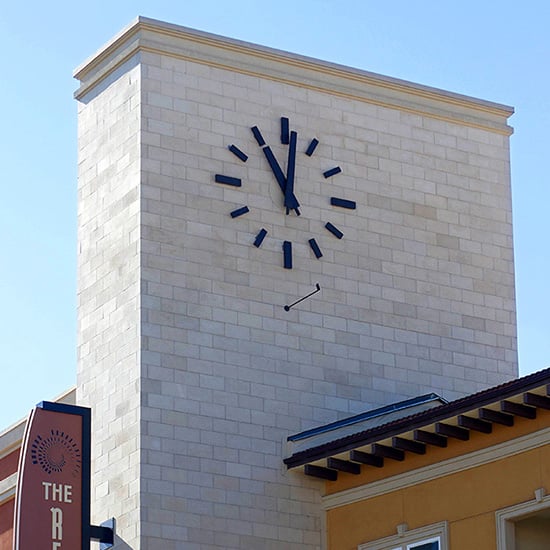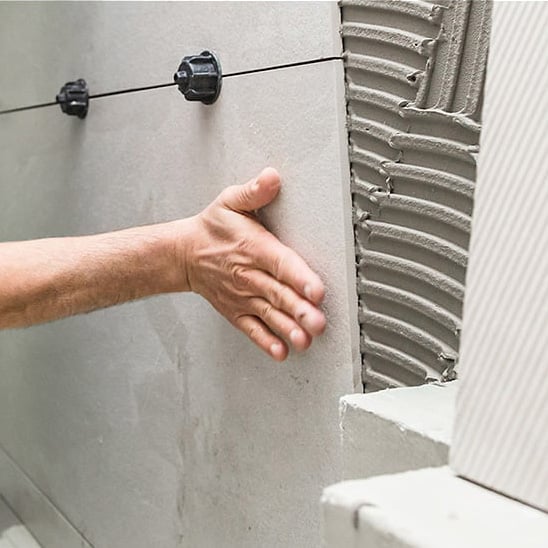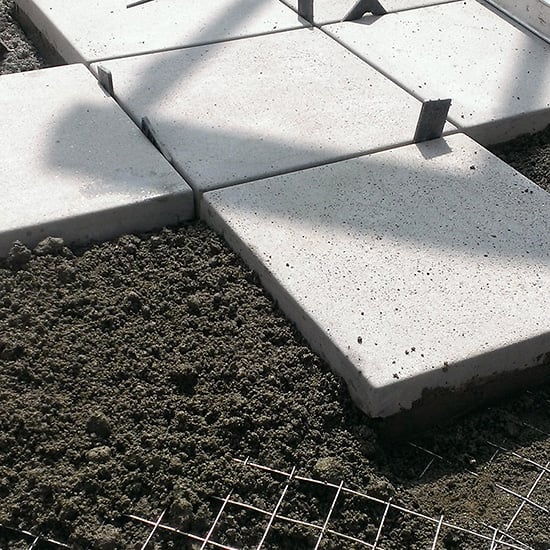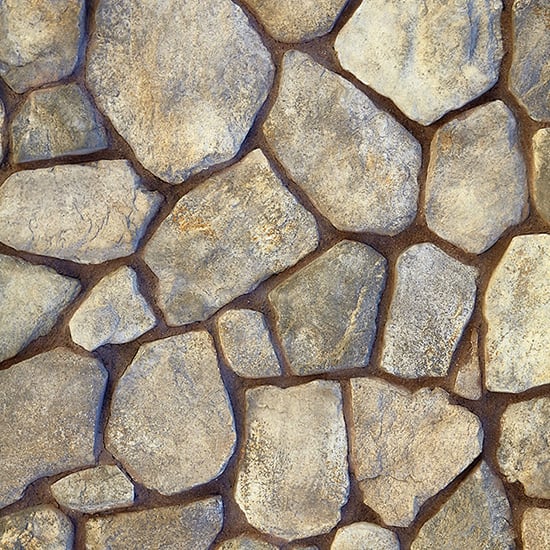HESSLITE BONDING MORTAR
VBM BondMate Bonding Mortars are designed for MEDIUM BED bonding applications with mortar beds greater than 1/4". Medium bed bonding mortars are intended for use over rough or uneven substrates, such as lath or wire, cement plaster, rough-finished concrete, or concrete masonry units. Three product variations (performance levels) are available in the VBM BondMate product class.
VBM BondMate 100 is a polymer modified, lightweight medium bed (GREATER than 1/4") bonding mortar that represents a great combination of high performance and economy, featuring high bond strength, non-sag, and efflorescence resistance. Includes antimicrobial additives. Bond strength typically greater than the substrate.
SPECIFICATIONS: Level 1 performance product. Meets the property specifications of ANSI 118.4 shear bond (tile). Manufactured in accordance with ASTM C1714.
USES: VBM BondMate 100 is designed specifically for installation of grouted masonry veneer and tile—including natural stone, manufactured stone, thin brick, precast concrete, ceramic tile and pavers (pedestrian traffic). Suitable for interior or exterior applications over rough or uneven substrates.
DATA SHEET: VBM BondMate 100 • (PDF)
VBM BondMate DryStack/LFT is a polymer modified, lightweight medium bed (GREATER than 1/4") bonding mortar for use over rough or uneven substrates. DryStack/LFT is workhorse of our polymer-modified medium bed bonding mortar line, featuring extra tack, water retention, water repellency, and efflorescence protection. Includes antimicrobial additives.
SPECIFICATIONS: Level 2 performance product. Meets the property specifications of ANSI 118.4 shear bond (tile). Manufactured in accordance with ASTM C1714.
USES: VBM BondMate DryStack/LFT is designed specifically for adhering Large Format Tile (LFT) and stone as well as drystack installations that have limited or no grout joint. Also use to adhere cast board forms, pavers (pedestrial traffic), and panelized units of manufactured stone or brick. Suitable for interior or exterior applications over rough or uneven substrates.
DATA SHEET: VBM BondMate DryStack/LFT • (PDF)
VBM BondMate Premium is a polymer modified, lightweight bonding mortar for applications requiring a medium mortar bed GREATER than 1/4" over uneven or rough substrates. Provides advanced bonding for large and heavy veneers. Contains our highest polymer modification for exceptional flexural bond and water repellency. Includes antimicrobial additives.
SPECIFICATIONS: Level 3 performance product. Meets the property specifications of ANSI 118.15 shear bond (tile). Manufactured in accordance with ASTM C1714.
USES: Designed specifically for difficult bonding applications of manufactured stone, natural stone, thin brick, precast concrete, concrete pavers, certain tile or similar masonry veneers and pavers. Recommended for the most demanding projects, like heavy veneers, horizontal paver applications, or paver installation with vehicle traffic. Suitable for interior or exterior applications over rough or uneven substrates.
DATA SHEET: VBM BondMate Premium • (PDF)
Description
Advantages. VBM BondMate veneer bonding mortars have these advantages:
• Lightweight for easy handling and reduced structural loading, reducing weights by ‹100 lbs/cu.ft.
• Freeze-thaw durability.
• High shear bond strength.
• Low shrinkage.
• Extra tack and non-sag properties.
• Water repellent
Colors. Available in standard gray, soft white.
Packaging. VBM BondMate mortars are available in 50 lb. moisture resistant bags.
Coverage. Coverage can vary based on job conditions and application thickness. Yield is approximately 0.58 cu.ft. per 50 lb. bag. At 1/2" thickness, coverage is approx. 14 sq.ft.
Shelf Life. When stored in a cool dry area, with low humidity: approximately 6–12 months.
Efflorescence. All VBM BondMate mortars reduce the potential for efflorescence. Polyblends offer the greatest water repellency, however due to variables beyond our control, we cannot guarantee against efflorescence.
Suitable Substrates. See INSTALLATION; Substrates.
Limitations. Please note and abide by the following limitations:
• Do not apply when temperatures are below 40° F prior to cure.
• Do not add any admixtures without prior consent.
• Follow ANSI, TCA, or ASTM guidelines for installation in high heat, cold or wind.
• Always perform quality control testing before and during application.
• Not recommend over particle board, plywood, Luan, or hard wood floors.
• Not recommended for green marble or water-sensitive stone.
Technical Data
VBM BondMate mortars contain Portland Cement (ASTM C150), graded lightweight aggregate, Type S Lime (ASTM C207), R-Mortar Aid and proprietary polymer additives. Manufactured in accordance with ASTM C1714. VBM BondMate mortars meet the property specifications of ASTM C270 Type-S. Compressive strength specimens must be air cured for 7 days prior to testing due to their high water retention and water repellency (per ANSI 118.1). All VBM BondMate mortars exceed IBC, CBC, and TMS-402/602 requirements of a minimum of 50 psi shear bond strength requirements (ASTM C482 modified). All VBM BondMate mortars exceed the shear bond strength requirements of ANSI 118.4–Latex Modified Mortars (tile 1/4" thick; >300psi). VBM BondMate Premium meets the shear bond requirements of ANSI 118.15.
Installation
Substrates All substrates must be clean and free from any dirt, oil, paint, bond breakers or any substances which may hinder bond. The substrate must be structurally sound and conform to good engineering practices. Substrate deflection under all live, dead and impact loads, including concentrated loads must not exceed L/360 for thin bed installation or L/480 for thick bed stone installations, where L=span length. Installations shall be in accordance with building codes. Movement joints shall be brought through mortar and veneer to the surface. Reference ASTM, TCNA, MVMA installation guide, local building codes and ASTM C1780 Standard Practice for Installation Methods for Adhered Manufactured Stone Masonry Veneer.
SUITABLE SUBSTRATES (properly prepared and sound) include:
• Concrete Block (Untreated)—Directly adhered, or lath and plaster may be attached.
• Wood or Steel Studs—Cover with an approved sheathing, then lath and plaster.
• Lath and Cement Plaster—Lath and cement plaster shall conform to IBC, CBC, ASTM guidelines, and veneer manufactures requirements. Allow to cure 72 hours prior to application. We recommend HessLite MAC Scratch & Brown (or PM) to provide a high strength, water-resistant plaster substrate.
• Poured in Place Concrete (Prepared) and Tilt Up Concrete (Prepared)—Ensure all form release agents and bond breakers are completely removed; mortar will not bond to surfaces with any trace of release or breaker agents still on the substrate. This is best achieved by removal of the surface layer by bead blasting, grinding or equivalent. The substrate must still be checked to assure complete removal of any bond inhibiting substances. Smooth concrete must be roughened. High pressure washing is typically not adequate for complete removal of bond breakers or release agents. If a bond-ready surface cannot be achieved, install lath and a scratch coat. Concrete should be well cured. 28 days recommended.
• Cement backer board (Prepared)—A VBM PolyThin thinbed mortar must be used as the bonding mortar on cement backer board. Additional damp proofing / waterproofing may be required in some applications. Application shall be approved by the stone or brick manufacturer. All joints must be taped with fiberglass tape and joints filled with VBM PolyThin Premium, R-Lastic, or equal. Consult cement backer board manufacturer for specific installation recommendations and limitations. A suitable substrate for bonding does not mean it is recommended for all veneer or job conditions.
Mixing Instructions
Proper mixing is critical for designed performance and workability. Please apply the following “best practices” for consistent success using HessLite Bonding Mortars.
• Do not over-mix. Do not mix at high speed. Lengthy and/or high-speed mixing will entrap air in the mix, resulting in lower strengths and poor workability.
• Best non-sag is achieved with mud mixed to a drier consistency. Correct water volume is critical to achieving good non-sag properties—HessLite bondng mortars are mixed at a much dryer consistency than Type-S mortars.
• Allow the mud to slake. The lightweight aggregate in HessLite bonding mortars will continue to absorb water as the mud rests. Then gently remix for 30 seconds. If necessary, adjust consistency by adding additional water. Take note of total water content used and repeat with subsequent batches.
• Test the Bond. Apply mortar to back of veneer and firmly press into the substrate. Wait for one minute, then remove. If mud is mixed properly, there will be equal amounts of mortar on substrate and veneer.
MIXING STEPS
1 • Add VBM BondMate bonding mortar to clean water (use approximately 5 to 5½ quarts of water per 50 lbs. of dry bonding mortar; about 22 to 24% by weight) and mix approximately 3 to 5 minutes at LOW SPEED. Mortars may be mixed in a mechanical paddle mixer or in smaller bucket-batches with a drill and mixing blade. DO NOT OVER MIX to avoid excessive air entrainment.
2 • Allow to slake for 7 to 10 minutes for full hydration.
3 • Gently re-mix and adjust consistency with additional water if necessary.
RESOURCE: HessLite VBM Mixing Guide • (PDF)
RESOURCE: HessLite VBM SPANISH Mixing Instructions Card • (PDF)
Application
Two methods of application may be used depending on the veneer and substrate.
Method A: [Wet-to-Wet]: Dampen the substrate and apply a leveling coat of BondMate to the substrate (100% coverage), firmly pressing / keying the mortar into the substrate. Spread only as much mortar as can be covered in 10 to 15 minutes (to avoid skin-over). Next, skim and back butter (100% coverage) the veneer/paver and firmly press into the wet leveling coat with enough pressure to force mortar out around the entire perimeter. Use the correct size notched trowel to make sure veneers can be fully embedded (100% coverage). Mortar bed shall be a minimum of 1/4" thick. Again, ensure full mortar coverage on both veneer and substrate.
Method B: Key in skim coat to back of veneer, then back butter (100% coverage) and press onto the substrate with enough pressure to force mortar out around the entire perimeter. Use the correct size notched trowel to make sure veneers are fully embedded (100% coverage). Mortar bed shall be a minimum of 1/4" thick. Method A (wet-to-wet) typically provides the best bond and is recommended for more difficult bonding applications.
Quality Check: Verify full coverage and bond by periodically removing and inspecting the back of a freshly-applied tile or veneer unit. Note that tile or veneer pieces that have been set for more than 10–15 minutes cannot be readjusted. Check work during the course of the day to insure good bond and coverage also check the previous day’s work to assure good application techniques and mortar bond.
Some natural stone absorbs heat at a high rate, it is important to minimize the temperature at the back of the stone surface—high temperature can hinder the bond to the surface; shade stone as needed.
NOTE: IT IS THE RESPONSIBILITY OF THE USER TO ENSURE THE MORTAR IS SUITABLE FOR THE INTENDED APPLICATION, THE SUBSTRATE IS PROPERLY PREPARED, AND APPLICATION IS PERFORMED CORRECTLY. TEST/QUALITY CONTROL ON PRE-CONSTRUCTION MOCK-UP.
Admixtures. Replacing all or part of the mix water with R-FlexAd will increase flexural bond and impact resistance. Recommended for difficult substrates or for areas subject to vehicle traffic.
Joint Grouting/Pointing. Use of HessLite MAC Fine Pointing Mortar is recommended. Allow bonding mortars to fully set (minimum 24 hrs) prior to grouting to assure bond is not disturbed. This mortar also contains efflorescence reducing additives.
Warranty
The technical information and usage statements are based on our best knowledge. The contents of these specifications are presented for informational purposes only and do not constitute responsibility for their use. The manufacturer will replace only that material which is proven defective due to quality of the components or the manufacturing process.
Cautions
Prolonged exposure to dust may cause delayed lung disease. Eliminate exposure to dust. Use NIOSH approved mask for silica dust. Freshly mixed materials may cause skin irritation. Avoid direct contact where possible and wash exposed skin areas promptly. If any cementitious materials get into the eyes, rinse immediately and repeatedly with water and get prompt medical attention.
Note: Testing for crystalline silica (airborne particles of respirable size) has shown no measurable rates of Crystalline Silica (Si02) to be present in HessLite VBM Bonding Mortars.
Warning: Products containing crystalline silica (airborne particles of respirable size) are known to the State of California to cause cancer. For more information go to www.p65Warnings.ca.gov
DATA SHEET: HessLite Safety Data Sheet (SDS) • (PDF)






CONTACT US
PRODUCT MANAGEMENT & SUPPORT
Jason (x142) or Matt (x138)
208.766.4777
• • •